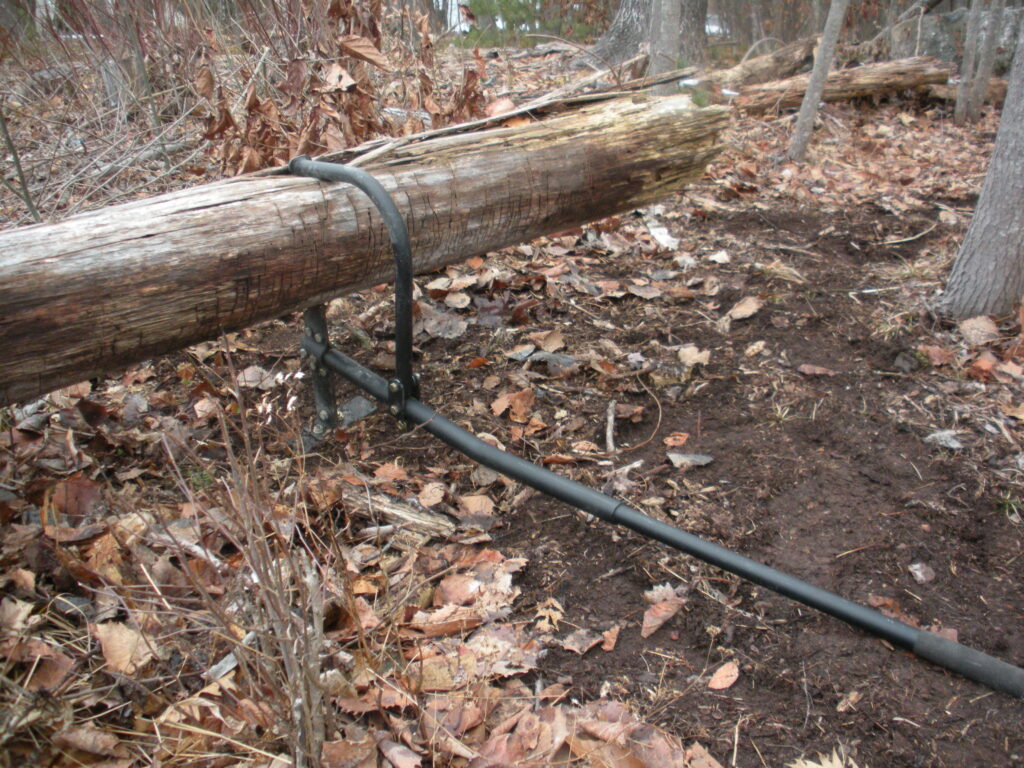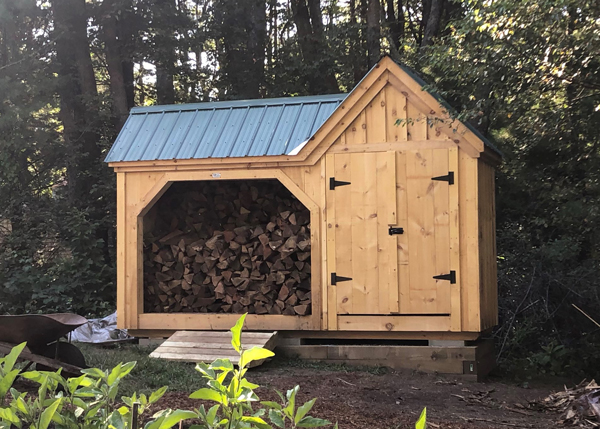BACK PAIN FROM SPLITTING FIREWOOD? Here’s What I do…
It’s inevitable. If you cut, split, stack or burn firewood, you will eventually use your back muscles. There’s no getting around it. Physical activity will always play a part in your wood burning experience.
Felling the tree – saw cutting small, manageable chunks – splitting those chunks for even smaller pieces – then finally, transporting the supply to where you are going to burn it. Lifting and carrying, bending, pushing and pulling – it’s all part of the process, the daily grind…a day in the life of a wood burner. In the end, we are blessed with an abundant supply of firewood, a reward for our efforts, a sense of satisfaction for a job well done. Unfortunately, along with the triumphs from the hard days’ work, your body may begin to sing a different tune…pain. You’re lucky if it’s only because your tired or from muscle soreness, something a few Ibuprofens can wane away. But if it’s back pain…
I ADMIT I’VE LEARNED THE HARD WAY. In the past I’ve worked too hard, too long and without the proper tools. My stubbornness cost me pain, along with some serious back issues. Since I wasn’t about to give up burning wood for heating my home, or the fun I had with outdoor fires, I needed to figure out ways to protect my body while collecting firewood. I became smarter with how I worked, and I started using the right tools for the job.
HERE IS HOW I PROTECT MY BACK WHEN HANDLING FIREWOOD
First, I have a few PERSONAL RULES I religiously abide by…
STRETCH – WARMUP Whether you are chain-sawing, stacking or transporting your wood supply, it involves some form of muscle movement. Before any outdoor task, I take 5 minutes and slowly perform a few exercises that prepare my body for strenuous movement.
TIME LIMITS It’s easy to lose track of time while doing your tasks. I used to work until my body couldn’t give any more…mistake…by then it was too late. Avoid the trap of telling yourself; “Just one more tree to cut” or “I’ll stack one more pile then quit”. Know your threshold for exhaustion and set a strict time limit on when to stop working.
NO ALCOHOL – Hydrate with water only. Save that ‘cold one’ for when the work is done. I always experience a sense of satisfaction when my work is finished – when I can troll around, admiring the felled trees or stacks of firewood…with a ‘cold one’ in my hand of course.
A BACK BRACE This is a ‘must have’ for me. I never cut, split or stack without wearing one. It’s inexpensive and it really helps to support my lower back. Also, another perk; it acts as a reminder to ‘lift less’ or at the least, ‘lift properly’. If you need one, I found that Amazon has the best selection and pricing. Click HERE to see their Best Seller.
FINALLY, listed below are a few of my own CREATIVE TECHNIQUES along with some TOOLS I use to PROTECT MY LOWER BACK WHILE HANDLING FIREWOOD
1. BALANCE THE LOAD
With all the wood I’ve carried over the years, one of the safest ways was to keep the weight ‘balanced’. It not only allowed me to move more wood at one time, but there was less chance of strain on my back when I did it this way. A good example is shown below.

2. HYDRAULIC LOG SPLITTER
Save the ax and maul splitting for special occasions where you have only a few logs. In fact, I do my best to avoid using them at all. They put extreme pressure on the back and if you run into a gnarly piece of wood, you run the risk of hurting yourself…all for the sake of one piece of wood? I highly recommend a gas-powered hydraulic log splitter. Let a machine do the hard work. Nowadays you can buy one online with free shipping right to your front door! Click HERE for the powerful model I recommend. Remember, using the unit in the vertical position allows for little bending. Get yourself a good pair of kneepads and try kneeling when splitting.
3. ROLL THE WOOD
Trees grow everywhere – including mountain tops, hillsides and sloping fields. Whenever the opportunity, try ‘rolling the wood’ as opposed to ‘lifting it’. I often find myself working alone, cutting, splitting or stacking my supply. This is when you really need to be creative and wise towards your work methods. I’ve already rolled large tree trunks down a hill straight onto the back of my pickup truck. I’ve rolled tree trunks onto the bucket attached to the front of my quad and of course I rolled the same trunks onto my brother’s custom-made log splitter.

It took only a half hour of my time, some spare lumber and a few screws and voila’, a ramp that was a good fit for the log splitter.
4. SKIP THE STACKING
I know, one of the best ways to properly season and store firewood is by stacking it (for air flow) and by covering the top of the pile (protection from the elements). But with stacking, you are adding another process where you’ll be required to handle the wood yet one more time. If you’ve got a lot of wood, there’s going to be a lot of bending over.
Try this: Skip the stacking altogether. Simply toss the split wood onto a pile at the location where your splitting (see bungee/tarp method HERE). Make sure you’re splitting the wood at a place where you can leave the pile covered until its ready to burn. If you’ve got a storage shed, split the wood right there, and toss it straight into the shed or storage unit (as opposed to stacking). Build the pile as tall as you can, so when retrieving, you may only have to bend over for the logs at the very bottom.
5. USE YOUR KNEES
One of the most demanding positions for my body is when I’m bending over bucking trunk wood. One of the tricks I use now is I kneel when making the cuts. Depending how large (the diameter) the tree and especially if it’s a hard wood, it will take a while for the cut to go through and that can be straining your lower back. But with kneeling, it not only saves me strength, but I actually have more control over the chainsaw when cutting.

I also kneel when splitting wood too. Below, I am splitting large trunks. No lifting. I simply roll the wood to the splitter and using its vertical setting, I’m able to keep my back straight most of the time.

HAVE YOU EVER USED THESE TOOLS? (They help with moving the heavier wood)
LOG LIFTERS


I can’t say enough good about these log lifters. I make sure to have them with me every time I cut, split or stack firewood. No more bending over to pick up logs with both hands. I own a pair of them so I can properly ‘balance the load’. I highly recommend these log grippers.
TIMBERJACK
I’ve often hurt myself while trying to move or dislodge a felled tree. My goal was simple – to buck the tree into manageable lengths to split for my woodstove. I would bend over, cutting three-quarters of the way through the trunk…the cuts spaced 16″ apart across the entire length of the tree. But then I would have to turn the tree to finish the saw cutting from the other side. A rather laborious task involving pushing and pulling…straining my lower back. But here’s how I do it now…

If you don’t already own one, you need a timberjack. This tool easily lifts trees off the ground to allow for ‘straight thru’ saw cutting. A must-have tool for any wood burner who cuts their own firewood. Check this out…it’s a 3-in-1 forestry multi-tool…a true back-saver! More info HERE
WHEELBARROW (2-WHEELED version!)
The pic below says it all….my wheelbarrow holds a lot of firewood, and it’s ‘waist high’ too, no bending over to access the firewood. Plus, it makes for easy transporting and temporary storage too. I simply wheel the wood close to where I intend to burn – in my outdoor firepit or near the basement door where the wood stove waits inside for its next feeding. No need to stack the wood either, as most times I use it right out of the wheelbarrow.

TIPS: Make sure the tray is made of a plastic material. The metal version is too heavy. Also, the tires are very important…you need the 2-wheeled version for sure, as it balances and secures the load more safely than the single tire model. Pneumatic (air-filled) tires are better too. They make it easier to maneuver irregular terrain while carrying heavier weight. Amazon has one that includes all these features plus a loop handle. See it HERE.
Final Thoughts…
Whether you burn firewood occasionally or full time, you will eventually have to handle the wood in some way, shape or form. It still comes down to protecting your body and being wise about how you cut, stack and burn firewood. I hope you may have learned something from my personal experiences where I discovered ways to protect my back along with the tools that helped me along the way. Until my next post, be careful and discover your own safe methods on how to protect your body while completing your wood burning tasks.
Have any ideas, tips or stories to share? Comments? Please don’t hesitate to contact. I would like to hear from you!
Be safe,
BZ
My FREE newsletter includes more tips, blog updates and exclusive offers for the email list only. Sign up HERE.









